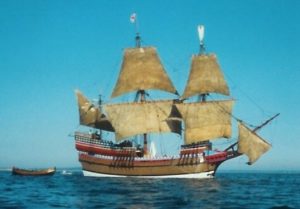Christopher Jones, a businessman and part owner of the Mayflower was from Harwich, England. He probably purchased it, along with Robert Childe, Thomas Short and Christopher Nichols in 1608 when he was 38 years old. It was a typical cargo ship carrying fish, lumber, tar, wine, cognac and vinegar.
 In 1620, the actual voyage of the Mayflower carrying Pilgrims took 66 days. But a cargo ship 25 feet wide and 106 feet long was not made to transport passengers. The voyage had begun on August 15 but their crossing of the Atlantic was delayed due to the leaky companion vessel, Speedwell which they had to sell and 20 of the Leyden Congregation had to remain in Plymouth. Departing Plymouth on September 6 (a Wednesday), a total of 102 passengers (half of which were of the Church) and a crew of more than 20, they landed on Monday, November 13 after having signed the Mayflower Compact on board on Saturday and having a church service on board on Sunday.
In 1620, the actual voyage of the Mayflower carrying Pilgrims took 66 days. But a cargo ship 25 feet wide and 106 feet long was not made to transport passengers. The voyage had begun on August 15 but their crossing of the Atlantic was delayed due to the leaky companion vessel, Speedwell which they had to sell and 20 of the Leyden Congregation had to remain in Plymouth. Departing Plymouth on September 6 (a Wednesday), a total of 102 passengers (half of which were of the Church) and a crew of more than 20, they landed on Monday, November 13 after having signed the Mayflower Compact on board on Saturday and having a church service on board on Sunday.
As a cargo ship, with its beams soaked in wine, it provided a sanitary effect that may have saved many lives. When the main beam cracked during a storm, the passengers had an iron screw which could support the beam “so they committed themselves to the will of God and resolved to proceed.” In addition, John Howland nearly died, falling overboard in a storm, yet “it pleased God that he caught hold of the topsail halyards which hung overboard and ran out at length.” These are all Providences of God. No wonder Bradford writes about their arrival in Provincetown “being thus arrived in a good harbor, and brought safe to land, they fell upon their knees and blessed the God of heaven.”
 No one knows what happened to the original Mayflower that transported the Pilgrims to the new world and returned in April of 1621. Places in England declare that they have parts of it, but none of that can be proven. Christopher Jones died in 1622, and by 1624 a probate document said the ship was “in ruinis” meaning it was probably being sold for scrap.
No one knows what happened to the original Mayflower that transported the Pilgrims to the new world and returned in April of 1621. Places in England declare that they have parts of it, but none of that can be proven. Christopher Jones died in 1622, and by 1624 a probate document said the ship was “in ruinis” meaning it was probably being sold for scrap.
In 1956, a replica hull without superstructure or sails was launched off the shores of Brixham, Devon, England to the sound of the Battle Hymn of the Republic played by the Somerset Light Infantry. A providential symbol of unity between America and England after World War II, this replica, designed by William A. Baker, was completed to reenact the actual voyage beginning April 20, 1957. Taking 55 days with 32 crew on board, it arrived at her resting place in Plymouth under the care of Plimoth Plantation on June 14, 1957.


